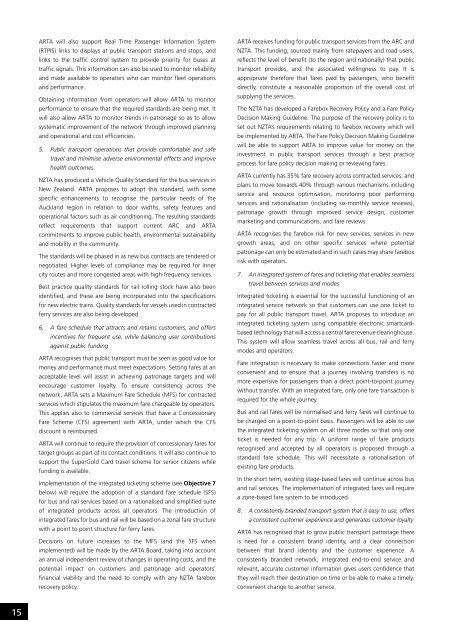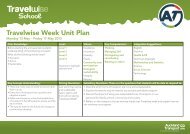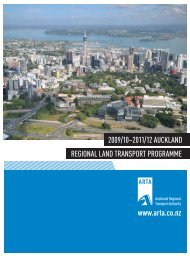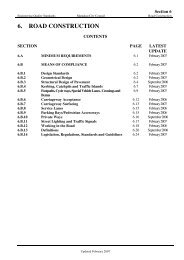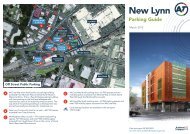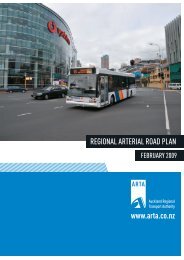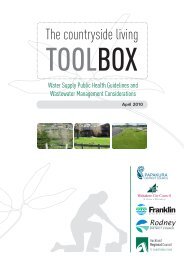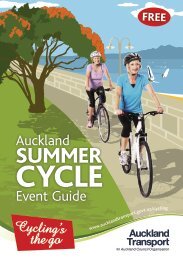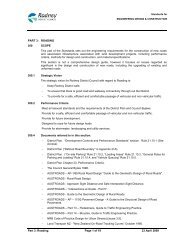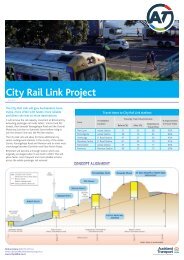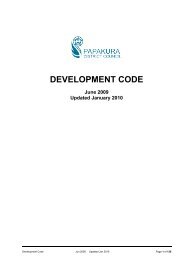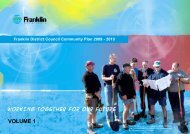www.arta.co.nz Auckland Regional Public Transport Plan 2010
www.arta.co.nz Auckland Regional Public Transport Plan 2010
www.arta.co.nz Auckland Regional Public Transport Plan 2010
Create successful ePaper yourself
Turn your PDF publications into a flip-book with our unique Google optimized e-Paper software.
ARTA will also support Real Time Passenger Information System<br />
(RTPIS) links to displays at public transport stations and stops, and<br />
links to the traffic <strong>co</strong>ntrol system to provide priority for buses at<br />
traffic signals. This information can also be used to monitor reliability<br />
and made available to operators who can monitor fleet operations<br />
and performance.<br />
Obtaining information from operators will allow ARTA to monitor<br />
performance to ensure that the required standards are being met. It<br />
will also allow ARTA to monitor trends in patronage so as to allow<br />
systematic improvement of the network through improved planning<br />
and operational and <strong>co</strong>st efficiencies.<br />
5. <strong>Public</strong> transport operations that provide <strong>co</strong>mfortable and safe<br />
travel and minimise adverse environmental effects and improve<br />
health out<strong>co</strong>mes<br />
NZTA has produced a Vehicle Quality Standard for the bus services in<br />
New Zealand. ARTA proposes to adopt this standard, with some<br />
specific enhancements to re<strong>co</strong>gnise the particular needs of the<br />
<strong>Auckland</strong> region in relation to door widths, safety features and<br />
operational factors such as air <strong>co</strong>nditioning. The resulting standards<br />
reflect requirements that support current ARC and ARTA<br />
<strong>co</strong>mmitments to improve public health, environmental sustainability<br />
and mobility in the <strong>co</strong>mmunity.<br />
The standards will be phased in as new bus <strong>co</strong>ntracts are tendered or<br />
negotiated. Higher levels of <strong>co</strong>mpliance may be required for inner<br />
city routes and more <strong>co</strong>ngested areas with high-frequency services.<br />
Best practice quality standards for rail rolling stock have also been<br />
identified, and these are being in<strong>co</strong>rporated into the specifications<br />
for new electric trains. Quality standards for vessels used in <strong>co</strong>ntracted<br />
ferry services are also being developed.<br />
6. A fare schedule that attracts and retains customers, and offers<br />
incentives for frequent use, while balancing user <strong>co</strong>ntributions<br />
against public funding<br />
ARTA re<strong>co</strong>gnises that public transport must be seen as good value for<br />
money and performance must meet expectations. Setting fares at an<br />
acceptable level will assist in achieving patronage targets and will<br />
en<strong>co</strong>urage customer loyalty. To ensure <strong>co</strong>nsistency across the<br />
network, ARTA sets a Maximum Fare Schedule (MFS) for <strong>co</strong>ntracted<br />
services which stipulates the maximum fare chargeable by operators.<br />
This applies also to <strong>co</strong>mmercial services that have a Concessionary<br />
Fare Scheme (CFS) agreement with ARTA, under which the CFS<br />
dis<strong>co</strong>unt is reimbursed.<br />
ARTA will <strong>co</strong>ntinue to require the provision of <strong>co</strong>ncessionary fares for<br />
target groups as part of its <strong>co</strong>ntact <strong>co</strong>nditions. It will also <strong>co</strong>ntinue to<br />
support the SuperGold Card travel scheme for senior citizens while<br />
funding is available.<br />
Implementation of the integrated ticketing scheme (see Objective 7<br />
below) will require the adoption of a standard fare schedule (SFS)<br />
for bus and rail services based on a rationalised and simplified suite<br />
of integrated products across all operators. The introduction of<br />
integrated fares for bus and rail will be based on a zonal fare structure<br />
with a point to point structure for ferry fares.<br />
Decisions on future increases to the MFS (and the SFS when<br />
implemented) will be made by the ARTA Board, taking into ac<strong>co</strong>unt<br />
an annual independent review of changes in operating <strong>co</strong>sts, and the<br />
potential impact on customers and patronage and operators’<br />
financial viability and the need to <strong>co</strong>mply with any NZTA farebox<br />
re<strong>co</strong>very policy.<br />
ARTA receives funding for public transport services from the ARC and<br />
NZTA. This funding, sourced mainly from ratepayers and road users,<br />
reflects the level of benefit (to the region and nationally) that public<br />
transport provides, and the associated willingness to pay. It is<br />
appropriate therefore that fares paid by passengers, who benefit<br />
directly, <strong>co</strong>nstitute a reasonable proportion of the overall <strong>co</strong>st of<br />
supplying the services.<br />
The NZTA has developed a Farebox Re<strong>co</strong>very Policy and a Fare Policy<br />
Decision Making Guideline. The purpose of the re<strong>co</strong>very policy is to<br />
set out NZTA’s requirements relating to farebox re<strong>co</strong>very which will<br />
be implemented by ARTA. The Fare Policy Decision Making Guideline<br />
will be able to support ARTA to improve value for money on the<br />
investment in public transport services through a best practice<br />
process for fare policy decision making or reviewing fares.<br />
ARTA currently has 35% fare re<strong>co</strong>very across <strong>co</strong>ntracted services, and<br />
plans to move towards 40% through various mechanisms including<br />
service and resource optimisation, monitoring poor performing<br />
services and rationalisation (including six-monthly service reviews),<br />
patronage growth through improved service design, customer<br />
marketing and <strong>co</strong>mmunications, and fare reviews.<br />
ARTA re<strong>co</strong>gnises the farebox risk for new services, services in new<br />
growth areas, and on other specific services where potential<br />
patronage can only be estimated and in such cases may share farebox<br />
risk with operators.<br />
7. An integrated system of fares and ticketing that enables seamless<br />
travel between services and modes<br />
Integrated ticketing is essential for the successful functioning of an<br />
integrated service network so that customers can use one ticket to<br />
pay for all public transport travel. ARTA proposes to introduce an<br />
integrated ticketing system using <strong>co</strong>mpatible electronic smartcardbased<br />
technology that will access a central fare revenue clearinghouse.<br />
This system will allow seamless travel across all bus, rail and ferry<br />
modes and operators.<br />
Fare integration is necessary to make <strong>co</strong>nnections faster and more<br />
<strong>co</strong>nvenient and to ensure that a journey involving transfers is no<br />
more expensive for passengers than a direct point-to-point journey<br />
without transfer. With an integrated fare, only one fare transaction is<br />
required for the whole journey.<br />
Bus and rail fares will be normalised and ferry fares will <strong>co</strong>ntinue to<br />
be charged on a point-to-point basis. Passengers will be able to use<br />
the integrated ticketing system on all three modes so that only one<br />
ticket is needed for any trip. A uniform range of fare products<br />
re<strong>co</strong>gnised and accepted by all operators is proposed through a<br />
standard fare schedule. This will necessitate a rationalisation of<br />
existing fare products.<br />
In the short term, existing stage-based fares will <strong>co</strong>ntinue across bus<br />
and rail services. The implementation of integrated fares will require<br />
a zone-based fare system to be introduced.<br />
8. A <strong>co</strong>nsistently branded transport system that is easy to use, offers<br />
a <strong>co</strong>nsistent customer experience and generates customer loyalty<br />
ARTA has re<strong>co</strong>gnised that to grow public transport patronage there<br />
is need for a <strong>co</strong>nsistent brand identity, and a clear <strong>co</strong>nnection<br />
between that brand identity and the customer experience. A<br />
<strong>co</strong>nsistently branded network, integrated end-to-end service and<br />
relevant, accurate customer information gives users <strong>co</strong>nfidence that<br />
they will reach their destination on time or be able to make a timely,<br />
<strong>co</strong>nvenient change to another service.<br />
15


